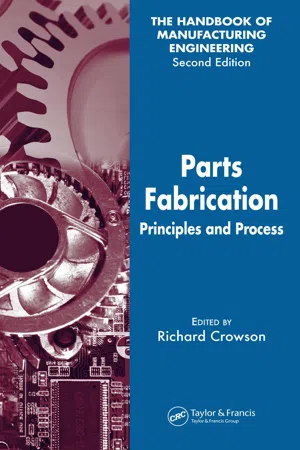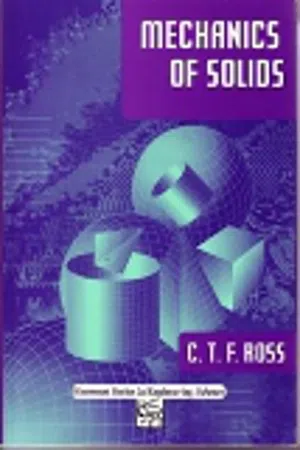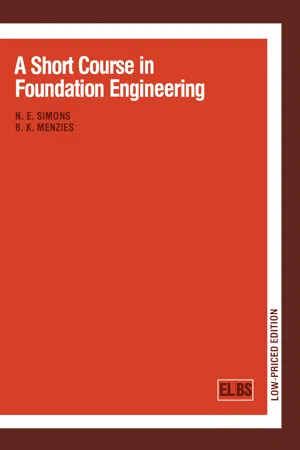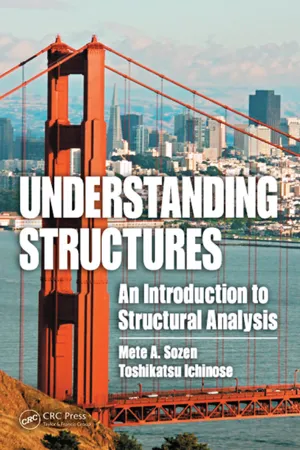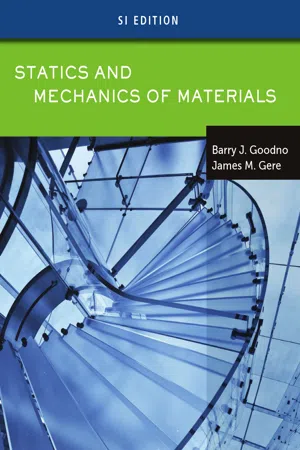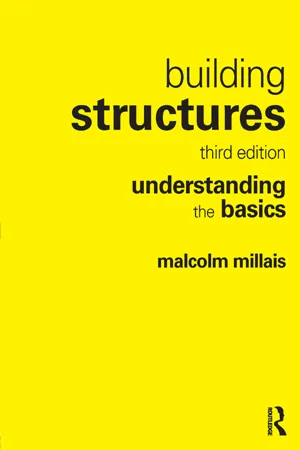Technology & Engineering
Shear Stress
Shear stress refers to the force per unit area that acts parallel to the surface of a material, causing it to deform or slide. It is a measure of the internal resistance of a material to shear forces and is important in the design and analysis of structures and materials. Shear stress plays a crucial role in determining the stability and strength of various engineering components.
Written by Perlego with AI-assistance
Related key terms
1 of 5
10 Key excerpts on "Shear Stress"
- eBook - ePub
- Robert L. Mott, Joseph A. Untener(Authors)
- 2021(Publication Date)
- CRC Press(Publisher)
shear . Shear Stress, of course, is a phenomenon of one layer of material tending to slide relative to the next layer. Shear Stress is very different from tension that pulls molecules apart or compression that tends to crush them together. Shear Stress, τ, was studied in previous chapters because of the cutting action of direct shear and the shearing stress that results when a member is loaded in torsion. In the case of bending, the shearing stress occurs horizontally along the length of beam, as one level of the beam is forced against the layers above and below it.As a designer, you need to be aware of this potential failure mode particularly in beams made of wood. The grain structure of wood does not provide strong resistance to shear along the grain lines, so wooden beams often fail in this way. In addition to wooden beams, any beam that has been made from multiple elements or layers joined by adhesives, welds, or fasteners must also be analyzed for shear. Other indicators for this failure mode are discussed later in the chapter. For now, look at the beam test performed in Figure 8–1 . The wooden beam has been placed in a three-point loading fixture on a universal testing machine as discussed in Chapter 2 . The test has been run to the point of failure for this wooden beam, and that failure occurred in shear. Look at the horizontal nature of the failure. Do you notice that the main area of failure is along the horizontal centroidal axis? This might be a surprise to you given that when analyzing bending stress, we referred to this as the “neutral axis” because of the lack of bending stress there. Failure in shear, though, actually quite commonly occurs along the horizontal centroidal axis because of the high shearing stress that occurs there.The test setup that you see in Figure 8–1 is precisely the type of test that would be used to determine values like those listed in Appendix A–15 - eBook - PDF
- Barry Goodno, James Gere, Barry Goodno(Authors)
- 2020(Publication Date)
- Cengage Learning EMEA(Publisher)
Due to electronic rights, some third party content may be suppressed from the eBook and/or eChapter(s). Editorial review has deemed that any suppressed content does not materially affect the overall learning experience. Cengage Learning reserves the right to remove additional content at any time if subsequent rights restrictions require it. Section 1.8 Shear Stress and Strain 53 The average Shear Stress on the cross section of a bolt is obtained by dividing the total shear force V by the area A of the cross section on which it acts, as aver V A t 5 (1-16) In the example of Fig. 1-50, which shows a bolt in single shear, the shear force V is equal to the load P, and the area A is the cross-sectional area of the bolt. However, in the example of Fig. 1-49, where the bolt is in double shear, the shear force V equals P/2. Equation (1-16) shows that Shear Stresses, like normal stresses, represent intensity of force, or force per unit of area. Thus, the units of Shear Stress are the same as those for normal stress, namely, pascals or multiples thereof in SI units. The loading arrangements shown in Figs. 1-49 and 1-50 are examples of direct shear (or simple shear) in which the Shear Stresses are created by the direct action of the forces trying to cut through the material. Direct shear arises in the design of bolts, pins, rivets, keys, welds, and glued joints. Equality of Shear Stresses on Perpendicular Planes To obtain a more complete picture of the action of Shear Stresses, consider a small element of material in the form of a rectangular parallelepiped having sides of lengths a, b, and c in the x, y, and z directions, respectively (Fig. 1-52). 4 The front and rear faces of this element are free of stress. Now assume that a Shear Stress 1 t is distributed uniformly over the right- hand face, which has area bc. - eBook - PDF
Parts Fabrication
Principles and Process
- Richard Crowson(Author)
- 2006(Publication Date)
- CRC Press(Publisher)
1 Principles of Structural Mechanics Jack M. Walker 1.0 INTRODUCTION TO MECHANICS This chapter is intended for those who may not have an extensive background in structural mechanics, or who have not used some of that knowledge recently and need a refresher. The working manufacturing engineer today is involved in product design, tool design, process selection and development (both parts fabrication and assembly), materials, and many other areas that require an analytical evaluation for proper understanding. In the field of metallurgy, for example, terms such as stiffness, stress, strength, elasticity, and so forth are the language involved—and sometimes we tend to use some of the terms incorrectly. In the fabrication of sheet metal parts, the elongation and yield strength are key elements. In machining, shear may play an important role in understanding cutting principles and selecting the proper cutting tool for a specific material. To understand the discussion of problems in materials and processes, it is essen-tial to know the basic principles of forces in equilibrium. Not all of the elements of today’s complex structural considerations are introduced here. Rather, the intent is to establish a set of definitions and relationships that are needed to understand terms such as tension, shear, compression, and bending . In order to use terms such as stiffness, yield strength, deflection, stress, and strain correctly, the author feels that mathematical relationships offer the only logical approach to definition and under-standing. Care has been taken to avoid the use of advanced mathematics; knowledge of arithmetic and high school algebra is all that is needed. It is the desire of this author to present some simple solutions to everyday structural problems to those individuals with little or no knowledge of mechanics. 1.1 DEFINITIONS OF FORCE AND STRESS 1.1.1 Force Force may be defined as that which exerts pressure, motion, or tension. - eBook - PDF
Physics of Continuous Matter
Exotic and Everyday Phenomena in the Macroscopic World
- B. Lautrup(Author)
- 2011(Publication Date)
- CRC Press(Publisher)
A stress that acts along the normal to a surface is called a tension stress whereas a stress that acts against the normal is called a pressure stress . A stress that acts along a tangential direction to a surface is called a Shear Stress . External and internal stresses The stresses acting in the interface between a body and its environment are external . As for pressure we shall also speak about internal stresses acting across any imagined surface in the body. Internal stresses abound in the macroscopic world around us. Whenever we come into contact with the environment (and when do we not?), internal stresses are set up in the materials we touch, as well as in our own bodies. The precise distribution of stress in a body depends not only on the external forces applied to the body but also on the types of material the body is made from and on other macroscopic quantities such as temperature. There is no guarantee that the normal stress is the same for any choice of surface through a given point. The proof of Pascal’s law (page 26)—that the pressure is the same in all directions of the surface normal—assumed that the material was a fluid at rest. For fluids in motion and for solids in general, this proof does not hold, but there is a generalized version of the theorem. In the absence of external forces there is usually no internal stress in a material, although fast cooling may freeze stresses permanently into certain materials, for example glass, and provoke an almost explosive release of stored energy when triggered by a sudden impact. Estimating stress -F F A A Clamped slab of homogeneous material. The shear force F at the upper clamp is balanced by an oppositely directed fixation force F on the lower clamp. The Shear Stress D F =A is the same on all inner planes parallel with the clamps (dashed). In many situations it is quite straightforward to estimate average stresses in a body from a knowledge of the external forces that act on the body. - Rodrigo Salgado(Author)
- 2022(Publication Date)
- CRC Press(Publisher)
1 Extremely large strains, particularly extremely large shear strains, are closely tied to concepts of rupture, yield, and failure. These three terms do not completely define the range of problems we deal with, so we will introduce appropriate terms throughout this chapter and the remainder of the text.4.1.2 Stress
A significant amount of the work we do in geotechnical engineering is based on the concept of stress. Stress is a concept from the mechanics of continuous bodies. Because soil is not a continuous medium, it is useful to discuss the meaning of stress in soils. Consider a small planar area A passing through point P located within a soil mass (Figure 4.1 ). A normal force FN and a tangential force FT are applied on A (these forces result, as discussed previously, from boundary loads and the soil self-weight or other body forces, which propagate through the soil mass until they reach the small area A). If soil were a continuum, the normal stress σ acting normal to A at point P would be defined as the limit of FN /A as A tends to the point P (that is, tends to zero, centered around P). The Shear Stress is defined similarly. Mathematically:Figure 4.1Definition of stress in soils: as the area A is allowed to shrink down to a very small value, the ratios FN /A and FT /A approach values σ and τ, the normal and Shear Stresses at P, respectively.σ =(4.1)limA → 0F NAτ =(4.2)limA → 0F TABecause soil is not a true continuum, we must modify this definition. A point within a soil mass is defined as a volume V0 that is still very small compared with the dimensions of the foundations, slopes, or retaining structures we analyze, but is sufficiently large to contain a large number of particles and thus be representative of the soil.2 With this representative elementary volume V0 , often referred to as the REV, we associate a representative area A0 (also very small, of a size related to that of V0 ). So we modify Equations (4.1) and (4.2) by changing the limit approached by the area A from zero to A0- eBook - PDF
- Carl T. F. Ross(Author)
- 1999(Publication Date)
- Woodhead Publishing(Publisher)
-14,.-----Shear Stresses in bending and shear deflections 14.1 Introduction If a horizontal beam is subjected to transversely applied vertical loads, so that the bending moment changes, then there will be vertical shearing forces at every point along the length of the beam where the bending moment changes (see Chapter 1). Furthermore, if the cross-section of the beam is of a built-up section, such as a rolled steel joist (RSJ), or a tee beam or a channel section, then there will be horizontal shearing stresses in addition to the vertical shearing stresses, where both are caused by the same vertically applied shearing forces. Vertical shearing stresses due to bending are those that act in a vertical plane, and horizontal shearing stresses are those that act in a horizontal plane. Later in this chapter, it will be shown that for curved sections such as split tubes etc., the shearing stresses due to bending act in the planes of the curved sections. Similar arguments apply to horizontal beams subjected to laterally applied horizontal shearing forces. To demonstrate the concept of shearing stresses due to bending, the variation of vertical shearing stresses across the section of a beam will be first considered, followed by a consideration of the variation of horizontal shearing stresses due to the same vertical shearing forces. 14.2 Vertical shearing stresses Consider a beam subjected to a system of vertical loads, so that the bending moment changes along the length of the beam, as shown in Figure 14.1. x---il---dx Figure 14.1 Beam subjected to vertical loads 384 Shear Stresses in bending and shear deflections 385 Consider an elemental length dx of the beam, as shown in Figure 14.2(a). Consider the sub-element of Figure 14.2(b), and also the sub-sub-element in the same figure, which is shown by the heavy line. - eBook - PDF
- N. E. Simons, B. K. Menzies(Authors)
- 2016(Publication Date)
- Butterworth-Heinemann(Publisher)
2 Shear strength 1 The definition of shear strength The shear strength of a soil in any direction is the maximum Shear Stress that can be applied to the soil structure in that direction. When this maximum has been reached, the soil is regarded as having failed, the strength of the soil having been fully mobilized. 2 The nature of shear strength When soil fails it does so by means of some plastic failure mechanism involving shear. The shear strength of a soil is derived from the structural strength alone, the pore-water having no shear strength. The resistance of the soil structure to shear arises from the frictional resistance, F, generated by the interparticle forces, 7V(Fig.2.1). In the soil mass, the loading transmitted by the soil structure normally to the shear surface is an integrated measure of these interparticle forces. Thus, the shear strength, 7y(Shear Stress at failure), on any plane in a soil, is some func-tion of the effective stress normal to that plane. Assuming a linear relationship gives T f =k l + k 2 (o n -u) (2.1) where o n is the total stress normal to the plane, u is the pore-water pressure, and k± and k 2 are two experimentally determined constants. Experiment has shown this expression to be substantially correct over a wide range of soils for a limited range of stresses. Soil particle Interparticle force normal to shear surface' Shear surface Relative displacement of soil in the mass Fig. 2.1 Forces arising at in ter-particle slip Load platen ^(applied normal load) Induced x/v// shear surface V///A y^ —^P(shear force) Soil specimen Fig. 2.2 A schematic section through the direct shear box Common usage has k x = c k 2 = tan0' whence Tf= c + (o n -u) tan (j) (2.2) (2.3) (2.4) where c is the cohesion intercept and 0' is the angle of shearing resistance, with respect to effec-tive stress. - eBook - PDF
Understanding Structures
An Introduction to Structural Analysis
- Mete A. Sozen, Toshikatsu Ichinose(Authors)
- 2018(Publication Date)
- CRC Press(Publisher)
In this section we exam-ine shear-stress distribution on a beam section. Before tackling the problem of shear-stress distribution over a beam section, we need to develop a set of definitions for stresses. Figure 4.4.2a shows an infinitesimal cube that is subjected to four stresses acting on the top face ADEH and side face ABEF. Axis x is perpendicular to face ABEF, and axis y is perpendicular to face ADEH. We focus on four stresses (also see Table 4.4.1 ): s : the normal stress acting in the direction of the x-axis on face ABEF s y : the normal stress acting in the direction of the y-axis on face ADEH t xy : the Shear Stress acting in the direction of the y-axis on face ABEF t yx : the Shear Stress acting in the direction of the x-axis on face ADEH The stresses s x and s y are called normal stresses because they act in a direction perpendicular to the faces of the cube ( Table 4.4.1 ). The stresses t xy and t yx , acting in x y σ x σ y D C B F E H x y z σ x σ x σ y σ y A B C D A B C D τ yx (a) Infinitesimal cube x y (b) Normal stress (c) Shear Stress τ xy τ vx τ xy τ yx τ xy A FIGURE 4.4.2 Stresses on an infinitesimal cube. Direction of Force Direction of face x x y y Shear Stress Normal stress τ xy τ yx (= τ xy ) σ x σ y TABLE 4.4. 1 Nomenclature for Normal and Shear Stresses 220 Understanding Structures: An Introduction to Structural Analysis directions parallel to the faces of the cube, are called Shear Stresses. Generally, there are normal as well as Shear Stresses on the face ABCD; but for simplicity we shall ignore them in order to be able to show them in two dimensions ( Figure 4.4.2b , c ). In Figure 4.4.2b , note that the equilibrium of forces requires a stress of s x on face DC and a stress of s y on face BC in the opposite direction to the normal stresses on faces AB and AD. In Figure 4.4.2c , similarly, t xy and t yx act on faces DC and BC. The equilibrium condition for moment leads to the following important equation. - Barry Goodno, James Gere(Authors)
- 2018(Publication Date)
- Cengage Learning EMEA(Publisher)
Hooke’s Law in Shear The properties of a material in shear can be determined experimentally from direct-shear tests or from torsion tests. The latter tests are performed by twist- ing hollow, circular tubes, thereby producing a state of pure shear. The results of these tests are used to plot Shear Stress-strain diagrams (that is, diagrams of Shear Stress t versus shear strain g). These diagrams are similar in shape to tension-test diagrams ( s versus «) for the same materials, although they differ in magnitudes. From Shear Stress-strain diagrams, you can obtain material properties such as the proportional limit, modulus of elasticity, yield stress, and ultimate stress. Numerical values of these properties in shear are usually about half as large as those in tension. For instance, the yield stress for structural steel in shear is 0.5 to 0.6 times the yield stress in tension. For many materials, the initial part of the Shear Stress-strain diagram is a straight line through the origin, just as it is in tension. For this linearly elastic region, the Shear Stress and shear strain are proportional, resulting in the fol- lowing equation for Hooke’s law in shear: G t g 5 (7-13) where G is the shear modulus of elasticity (also called the modulus of rigidity). The shear modulus G has the same units as the tension modulus E, namely, pascals (or multiples thereof) in SI units. For mild steel, typical values of G are 75 GPa; for aluminum alloys, typical values are 28 GPa. Additional values are listed in Table F-2, Appendix F. The moduli of elasticity in tension and shear are related by 2(1 ) G E 5 1 n (7-14) in which n is Poisson’s ratio. This relationship shows that E, G, and n are not independent elastic properties of the material. Because the value of Poisson’s ratio for ordinary materials is between zero and one-half, from Eq. (7-14) G must be from one-third to one-half of E. The following examples illustrate some typical analyses involving the effects of shear.- eBook - ePub
Building Structures
understanding the basics
- Malcolm Millais(Author)
- 2017(Publication Date)
- Routledge(Publisher)
Fig. 4.18 but the stresses will be curved across the shell.Fig 4.25As with the beam, the two sets of tensile and compressive stresses act as arch like curves. The compressive stresses move together at the top of the centre of the shell whereas the tensile stresses move together at the bottom.Fig 4.26It is often quite difficult to calculate the size and direction of the principal stresses for structures in general, however, if the pattern of the paths of the principal stresses can be visualised this gives a clear picture of how the structure is acting. With materials such as concrete or masonry, which cannot resist significant tensile forces, principal stress paths show where problems may occur or tensile reinforcement is needed.4.3 The role of Shear Stresses in beams
When beams do not have simple rectangular cross-sections, as is often the case, the actual behaviour can be quite complex. Fig. 3.52 shows a number of common non rectangular shapes used for beams and Fig. 3.55 shows the distribution of the bending stresses for an I beam. Fig. 3.64 illustrates the idea of shear area used in the simple design of non rectangular cross-sectional shapes.The idea of the new Shear Stress shown in Fig. 4.5 is crucial to the understanding of the complex behaviour of beams with non rectangular cross-sections. Although this Shear Stress is required for the equilibrium of a small cube cut from a beam, what does it contribute to the behaviour of a beam with a rectangular cross section? Suppose there are two beams of equal depth, one on top of the other and separated by a perfectly slippery surface.Fig 4.27The bent shape of the two beams will be the same, with the top of each beam shortening and the bottom lengthening (see Fig. 2.13 ). This means Abcde of the top beam gets longer and Abcde of the bottom beam gets shorter. Note that point C
Index pages curate the most relevant extracts from our library of academic textbooks. They’ve been created using an in-house natural language model (NLM), each adding context and meaning to key research topics.


